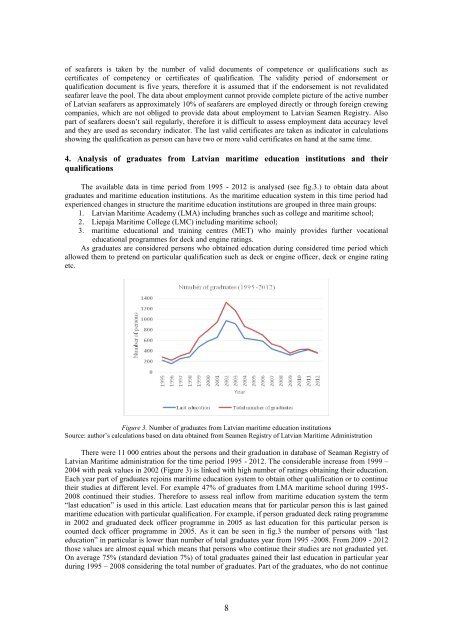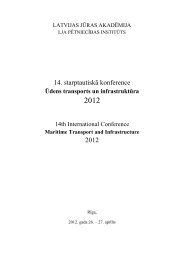You also want an ePaper? Increase the reach of your titles
YUMPU automatically turns print PDFs into web optimized ePapers that Google loves.
of seafarers is taken by the number of valid documents of competence or qualifications such ascertificates of competency or certificates of qualification. The validity period of endorsement orqualification document is five years, therefore it is assumed that if the endorsement is not revalidatedseafarer leave the pool. The data about employment cannot provide complete picture of the active numberof <strong>Latvian</strong> seafarers as approximately 10% of seafarers are employed directly or through foreign crewingcompanies, which are not obliged to provide data about employment to <strong>Latvian</strong> Seamen Registry. Alsopart of seafarers doesn’t sail regularly, therefore it is difficult to assess employment data accuracy leveland they are used as secondary indicator. The last valid certificates are taken as indicator in calculationsshowing the qualification as person can have two or more valid certificates on hand at the same time.4. Analysis of graduates from <strong>Latvian</strong> maritime education institutions and theirqualificationsThe available data in time period from 1995 - 2012 is analysed (see fig.3.) to obtain data aboutgraduates and maritime education institutions. As the maritime education system in this time period hadexperienced changes in structure the maritime education institutions are grouped in three main groups:1. <strong>Latvian</strong> <strong>Maritime</strong> Academy (LMA) including branches such as college and maritime school;2. Liepaja <strong>Maritime</strong> College (LMC) including maritime school;3. maritime educational and training centres (MET) who mainly provides further vocationaleducational programmes for deck and engine ratings.As graduates are considered persons who obtained education during considered time period whichallowed them to pretend on particular qualification such as deck or engine officer, deck or engine ratingetc.Figure 3. Number of graduates from <strong>Latvian</strong> maritime education institutionsSource: author’s calculations based on data obtained from Seamen Registry of <strong>Latvian</strong> <strong>Maritime</strong> AdministrationThere were 11 000 entries about the persons and their graduation in database of Seaman Registry of<strong>Latvian</strong> <strong>Maritime</strong> administration for the time period 1995 - 2012. The considerable increase from 1999 –2004 with peak values in 2002 (Figure 3) is linked with high number of ratings obtaining their education.Each year part of graduates rejoins maritime education system to obtain other qualification or to continuetheir studies at different level. For example 47% of graduates from LMA maritime school during 1995-2008 continued their studies. Therefore to assess real inflow from maritime education system the term“last education” is used in this article. Last education means that for particular person this is last gainedmaritime education with particular qualification. For example, if person graduated deck rating programmein 2002 and graduated deck officer programme in 2005 as last education for this particular person iscounted deck officer programme in 2005. As it can be seen in fig.3 the number of persons with ‘lasteducation” in particular is lower than number of total graduates year from 1995 -2008. From 2009 - 2012those values are almost equal which means that persons who continue their studies are not graduated yet.On average 75% (standard deviation 7%) of total graduates gained their last education in particular yearduring 1995 – 2008 considering the total number of graduates. Part of the graduates, who do not continue8
















